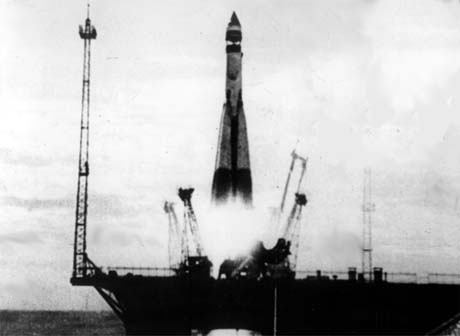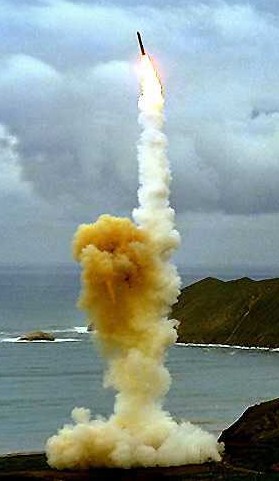| SPACE TODAY ONLINE COVERING SPACE FROM EARTH TO THE EDGE OF THE UNIVERSE | ||||||||||
| COVER | SOLAR SYSTEM | DEEP SPACE | SHUTTLES | STATIONS | ASTRONAUTS | SATELLITES | ROCKETS | HISTORY | GLOBAL LINKS | SEARCH |
Middle Eastern nation wants to be number 11:
Iran Plans to Launch a Space Satellite
OTHERS IN THE MIDDLE EAST AND SOUTH ASIA: PAKISTAN INDIA CHINA IRAQ ISRAEL
Iran is planning to modify one of its powerful Shahab-3 ballistic missiles and use it to blast a satellite to space, according to news reports from the region.
CIA map of Iran
A 44-lb. experimental satellite would be carried aloft to an orbit 155 miles above Earth. From there it would transmit a radio signal down to receiving stations on Earth.
The satellite may be named Safir-313. Safir is a Persian word for emissary.
The rocket. Iran has tested an upgraded version of the Shahab-3 that is strong enough to carry a warhead across the Middle East to Israel or U.S. bases in the Gulf. Its range is more than 800 miles.
Shahab-3 is not an original Iranian design. Rather, it is derived from the North Korean Nodong-1 ballsitic missile modified with Russian technology. If it were used as a weapon, a Sahab-3 missile could carry a nuclear warhead if such bombs were available to Iran.
About Iran. Iran is a country in the Middle East, bordering the Gulf of Oman, the Persian Gulf, and the Caspian Sea, between Iraq and Pakistan. Slightly larger than the U.S. state of Alaska, it is a place of mountains, deserts and plains.
MORE ABOUT IRAN »
And then there is Pakistan. On March 19, 2005, Pakistan successfully test-fired its Shaheen II missile, which has a range of 1,250 miles. It's designed to carry conventional and nuclear warheads, but would be powerful enough to launch a satellite to orbit.
CIA map of Pakistan
Pakistan is in Southern Asia, bordering the Arabian Sea, between India, Iran, Afghanistan and China. Mostly desert plains, mountains and plateaus, it's about twice the size of California.
MORE ABOUT PAKISTAN »
India, China, Israel, Iraq already up there. India became the eighth to demonstrate it could send a satellite to orbit above Earth with the July 18, 1980, launch of the satellite Rohini 1 on a Satellite Launch Vehicle (SLV) rocket.
MORE ABOUT INDIA »
Even earlier, China launched its first satellite – known as China 1 or Mao 1 – to orbit on a Long March rocket on April 24, 1970. It was the fifth nation able to launch its own satellite to orbit.
MORE ABOUT CHINA »
Iraq in space »
India in space »
China in space »
Israel in space »
Pakistan in space »
Afghan astronomy »
Israel became the ninth nation able to launch a satellite to orbit with the blast off on September 19, 1988, of its Horizon 1 or Ofeq 1 to orbit. It flew on a Shavit rocket from Israel's Palmachim Air Force Base south of Tel Aviv and Jerusalem near the town of Yavne in the Negev Desert. Shavit is Hebrew for comet. The rocket was a converted Jericho II medium-range ballistic missile.
MORE ABOUT ISRAEL »
Iraq launched a satellite on December 5, 1989, making it the tenth nation able to launch to orbit. The satellite was the 48-ton, third stage of a three-stage rocket in a flight from Al-Anbar Space Research Center 50 miles west of Baghdad. The rocket may have been a modified version of Argentina's Condor ballistic missile. Such a missile could carry a warhead 1,240 miles. Iraq also had a 600-mi.-range missile built around a Russian Scud missile.
MORE ABOUT IRAQ »
MAP OF THE MIDDLE EAST »
MAP OF ASIA »
Satellite Firsts
Around the world, 10 others already have accomplished the feat from the launch of the first satellite in 1957.
Iran had said in January 2004 that it was building a launchpad and wanted to be the first Islamic country in space. That seemed to overlook the fact that its neighbor Iraq had launched the third stage of a rocket into orbit in 1989. It wasn't clear whether Iran was separating itself from Iraq by categorizing its neighbor as a secular state.
The majority of satellites have been built by Russia and the United States, but the countries of Western Europe in the European Space Agency, as well as Japan, China, India, Canada, Israel, Brazil and others have been actively engaged in satellite development.
We refer to a spacefaring nation as a country with a rocket powerful enough for space launches. Spacefaring nations are those which launch their own satellites to orbit. They also launch satellites for others who do not possess the capability.
Below, in chronological order, are the first countries to loft their artificial moons to orbit above Earth:
Sputnik One rides Old Number Seven
1957 NOVOSTI PHOTO
A Missed Anniverary »
A Turning Point in History »
First American Satellite »
How High is Space? »
Iraq in space »
India in space »
China in space »
Israel in space »
Pakistan in space »
Afghan astronomy »
- USSR
1957 Oct 4
satellite: Sputnik 1
rocket: Old Number Seven
launch site: Baikonur Cosmodrome
- USA
1958 Jan 31
satellite: Explorer 1
rocket: Jupiter-C
launch site: Cape Canaveral
- France
1965 Nov 26
satellite: Asterix 1
rocket: Diamant
launch site: Algeria
- Japan
1970 Feb 11
satellite: Ohsumi
rocket: Lambda 4S-5
launch site: Kagoshima
- China
1970 Apr 24
satellite: Mao 1
rocket: Long March-1
launch site: Inner Mongolia
- Great Britain
1971 Oct 28
satellite: Black Knight 1
rocket: Black Arrow
launch site: Woomera Australia
- Europe
1979 Dec 24
satellite: CAT
rocket: Ariane
launch site: Kourou, French Guiana
- India
1980 Jul 18
satellite: Rohini 1
rocket: Satellite Launch Vehicle
launch site: Sriharikota Island
- Israel
1988 Sep 19
satellite: Horizon 1
rocket: Shavit
launch site: Negev Desert
- Iran
2009 Feb 3
satellite: Omid (Hope)
rocket: Safir-2 two-stage
launch site: Semnan
Dasht-e-Kavir desert
- North Korea
2012 Dec 12
satellite: Kwangmyongsong 3
(Lode Star 3)
rocket: Unha three-stage
launch site: Sohae
Satellite Launching Station
Satellites are part of daily life, used around the world for communications, weather forecasting, navigation, observing land, sea and air, scientific research, military reconnaissance and numerous other purposes.
In addition, hundreds of men and women have lived and worked aboard space shuttles and space stations, which are manned satellites in Earth orbit.
Missiles vs. Rockets
A ballistic missile is a rocket that fires its engines until all fuel is expended and then lets gravity drop its warhead payload onto a pre-planned target. It is a ground-to-ground weapon.
Iran's rocket and payload for spaceflight:Iran plans to modify a Shahab-3 to blast the small satellite up to such a high altitude above the atmosphere that it will be in orbit around Earth. The payload will stay up there for a period of time and then fall back down into the atmosphere and burn up.
- the medium-range ballistic missile, Shahab-3
- the 44-lb. satellite, Safir-31
Military missiles are categorized by their ranges. Here are the types:
- BSRBM is a battlefield short range missile capable of a very short flight of less than 100 miles.
- SRBM is a short range ballistic missile that travels from 100-500 miles. An example is the Russian SCUD missile, which has been exported to more countries than any other type of guided ballistic missile. Iraq fired 93 SCUDs during the Persian Gulf War in 1991. North Korea produced a version of the SCUD it called Hwasong.
Launch of a Minuteman ICBM
USAF photo- MRBM is a medium range ballistic missile that travels from 500-1500 miles. Iran's Shahab-3 missile has a range of 800 miles, which makes it an MRBM. It was derived from North Korea's No-dong missile as is Pakistan's Ghauri missile.
- IRBM is an intermediate range ballistic missile that can hit a target 1,500-3,400 miles away. IRBMs frequently have been turned into launchers for small satellites. This is accomplished by adding upper stages to the rocket. For example, during the early days of space launches in in the United States, the Thor, Redstone and Jupiter missiles were turned into space rockets. A modified Jupiter known as Jupiter-C launched America's first satellite, Explorer 1. Other examples of IRBMs turned into space launchers include Israel's Shavit rocket and North Korea's Taep'o-dong rocket.
- ICBM is an intercontinental ballistic missile that can strike a target 3,400 to 9,200 miles away. That makes it a global weapon. An ICBM has two or more rocket stages and flies up as high as 700 miles before dropping its warhead payload on a target. The United States, Russia, and China have operational ICBM warfare systems. Other nations, including India, Pakistan, Iran, Israel and North Korea, may have ICBMs, but not organized systems. Some examples of American ICBMs include Atlas, Titan, Minuteman and Peacekeeper. Recently, American Titan and Minuteman ICBMs, and Russian SS-9 Cyclone ICBMs, have been converted into space rockets.
BEATING SWORDS INTO PLOWSHARES
- SLBM is a submarine launched ballistic missile that can deliver a nuclear weapon payload. An example of an SLBM is the United States' Trident intercontinental ballistic missile, which is armed with nuclear warheads and launched from submarines. Russia's Shitl space rocket was derived from the SS-N-23 SLBM.
SUBMARINE NOVOMOSCOVSK LAUNCHES SATELLITES
Top of this page Satellites Search STO STO Cover Questions © 2004 Space Today Online



